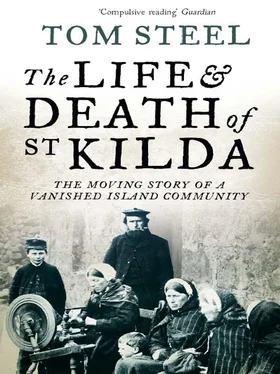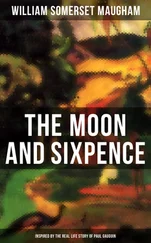For at least eight months of the year St Kilda, whose annual rainfall is about fifty inches, is subjected to frequent and severe gales and storms. Sudden and vicious, these storms are most common from September to March. Mary Cameron, daughter of one of the island’s last missionaries, remembers a storm that literally deafened the people of the village. ‘One particularly severe storm’, she writes, left us deaf for a week – incredible but true. The noise of the wind, the pounding of the heavy sea, were indescribable. This storm was accompanied by thunder and lightning, but we could not hear the thunder for other sounds. Our windows were often white with salt spray, and it was awe-inspiring to watch the billows and flying spindrift.’ On one occasion the entire village was destroyed in a gale, and sheep were frequently blown over the cliffs into the sea below. After a single night of rain, the island is literally running with water, and because of the steepness of the hillsides and the shallowness of the soil, the run-off is extremely destructive to crops.
Stormy weather inevitably meant privation to the St Kildans. ‘Their slight supply of oats and barley’, wrote Wilson in 1841, ‘would scarcely suffice for the sustenance of life; and such is the injurious effect of the spray in winter, even on their hardiest vegetation, that savoys and german greens, which with us are improved by the winter’s cold, almost invariably perish.’ Somehow the St Kildans survived that year as they had done in the past and were to do in the future. They placed little reliance on the scant crops the weather would allow them to grow. Their main source of food and income remained the sea birds that were gathered in the few summer months.
Winter on Hirta was less cold than might be expected. The archipelago lies in the path of the Gulf Stream and the sea helps keep the temperature higher. According to Wilson in 1841, the winter was mild and when ice formed it was little thicker than a penny. The St Kildans, however, claim that snow lay thick on the ground and there were often drifts deep enough to bury their sheep.
What was of greater concern to the people of Hirta was the rapidity with which the weather can change. The islands make their own weather as well as receiving the brunt of what rolls over the Atlantic, and within a period of twenty-four hours sunshine can make way for rain and rain for a storm. The St Kildans became weather forecasters par excellence; what to the outsider seemed a perfect day was frequently not a time to risk work either at sea or on the cliffs. ‘The islanders in general’, wrote the Reverend Kenneth Macaulay in 1765, ‘possess the art of predicting the changes of the weather perhaps in much greater perfection than many of those who are beyond doubt superior to them in some other branches of knowledge…The St Kildans owe much of their knowledge to the observations they and their predecessors have made on the screamings, flight, and other motions of birds, and more especially on their migrations from one place to another.’
To an outdoor race like the St Kildans, weather was all-important. The summer months on Hirta frequently made up for the misery of autumn, winter, and spring. June, July, and August were months of much sunshine. When John Mathieson, the geographer, was on St Kilda in 1927, he kept a complete meteorological record of the months April to October. During that time there were 627 hours of sunshine and eleven and a half inches of rain. In Edinburgh during the same period there were 644 hours of sunshine and fourteen inches of rain. The average day temperature was 63 degrees Fahrenheit, compared with 67 degrees Fahrenheit in the capital city. On many days, however, the weather was too hot for comfort, and because the island offers little shelter the St Kildans worked stripped to the waist. In the spring and summer months it was occasionally very humid. George Murray, the schoolmaster, claimed that the atmosphere was often so heavy on the island that it was difficult to keep awake, and Mathieson and Cockburn also found summer days far from invigorating.
But the St Kildans rarely left their sea-girt home and had little idea what it was like to live elsewhere. Only the occasional visitor gave them an insight into the affairs of the outside world. Not only did the islanders know nothing of what the weather was like in other parts of the United Kingdom, throughout most of their history they were blissfully unaware of the troubles of the people who lived there. Only on a few occasions did the affairs of the nation beyond involve them.
St Kilda’s reputation as the most isolated spot in the United Kingdom was quick to become widespread. As such it was suggested many times that the owner of the island, MacLeod of MacLeod, should offer the place up as a prison. For one woman the proposal became a reality. In the early eighteenth century Rachel Erskine Grange was virtually held captive on Hirta.
Lady Grange, as she came to be styled, was a bad-tempered woman totally opposed to the politics of her husband James Erskine of Grange, the Lord Justice Clerk, who was the brother of the Earl of Mar, leader of the 1715 Jacobite Rising. One night in 1731, when Jacobite sympathizers met at Lord Grange’s house in Edinburgh, Rachel listened in to their conspiratorial talk from beneath a sofa. After a time she could take no more, revealed herself and threatened to denounce her husband and his friends.
The assembled nobles realized that they would have to get rid of her. MacLeod of Dunvegan and MacDonald of Sleat agreed to secrete her in the remote parts of their island possessions, and that night she was quietly removed from the city, bound for the Isle of Skye. News of her death was spread in Edinburgh and a mock funeral at Greyfriars Church was arranged. Her relatives attended, wept, and tried to accept that she was no more.
MacDonald looked after Lady Grange for two years on the lonely island of Heisker, off North Uist. MacLeod of Dunvegan then took responsibility for her and had her deported to St Kilda. There she remained a virtual prisoner for eight years, from 1734 until 1742. On the island it is said that she ‘devoted her whole time to weeping and wrapping up letters round pieces of cork, bound with yarn, to try if any favourable wave would waft them to some Christian, to inform some humane person where she resided, in expectation of carrying tidings to her friends at Edinburgh’. The St Kildans were very hospitable, and put one of their houses at her disposal. She habitually slept during the day and got up at night throughout her period of exile, such was her dislike of the natives. The St Kildans, however, bore no malice and waited upon her royally. She was given the best turf on the island for her fire, and although food was scarce she never went without.
When it was thought that the danger had lessened, she was brought back to Uist, then to Assynt, and then to Skye where she was taught how to spin. She worked alongside the local women who regularly sent their yarn to Inverness, and on one occasion she managed to hide a letter in the yarn sent to market.
Months later the letter reached her cousin, the Lord Advocate. He was appalled by her harrowing account of her adventures and persuaded the government to send a warship to search the coast of Skye for her. But the men of the British Navy could find no trace of her, and MacDonald had her swiftly sent to Uist and then on to the Vaternish peninsula, where she died in 1745.
To this day, Lady Grange is the only woman in Scotland to have had three funerals. The conspirators were still afraid that their evil deed would be discovered, so they filled a coffin with turf and staged a second funeral in the little churchyard of Duirinish, while her body was secretly buried at Trumpan, above Ardmore Bay, on the Isle of Skye. Lady Grange stayed longer on Hirta than any outsider before or since, save the occasional minister sent by the Free Church of Scotland.
Читать дальше












